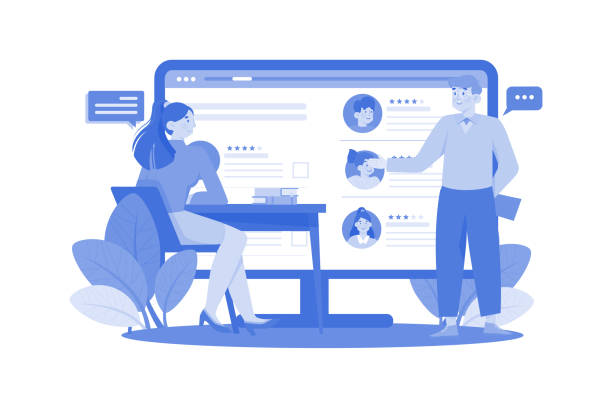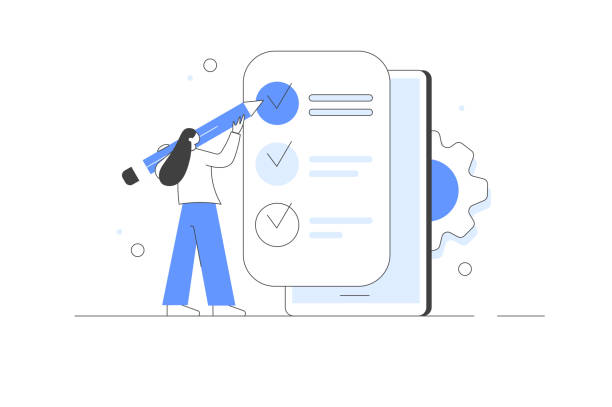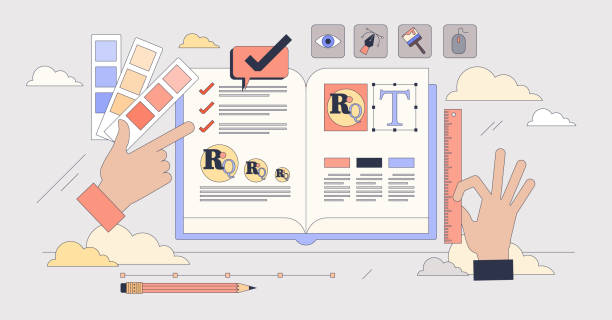Introduction to User Experience Optimization in Today’s Websites
![]()
In today’s digital world, #User_Interface and #User_Experience are two main pillars of success for any website.
It’s no longer enough to simply have a website; users expect to interact with a platform that is not only beautiful but also simple and enjoyable to use.
This is where the concept of modern UI web design becomes important.
Modern design goes beyond mere aesthetics, focusing on how the user interacts with the website and how they feel throughout this process.
This approach ensures that users can easily achieve their goals, find the information they need, and have a positive experience on the website.
Today, attention to small details in design can make a big difference.
Did you know that a website with a poor user interface can increase user bounce rates by over 50 percent? This statistic shows us that investing in modern UI design is not just an option, but a necessity.
This type of design aims to create a seamless and engaging user experience (UX) that brings a sense of satisfaction from the user’s first moment of entry to their last interaction.
This includes the layout of elements, color schemes, fonts, loading speed, and even how error messages are displayed.
Education and awareness of the latest trends in this field are vital for any web designer or business owner.
The ultimate goal of modern UI web design is to build websites that not only meet current user needs but are also scalable and sustainable for the future.
This means having a deep understanding of user psychology, knowing new technologies, and being able to implement them creatively to turn every visitor into a loyal customer.
Did you know that your company’s website is the first point of contact for 75% of potential customers?
Your website is the face of your brand. With **RasaWeb**’s corporate web design services, build an online presence that earns customer trust.
✅ Create a professional and lasting image for your brand
✅ Attract target customers and increase online credibility
⚡ Get a free consultation from **RasaWeb** experts!
Key Principles in Building Websites with Engaging User Interfaces

To achieve an engaging #User_Interface and unparalleled #User_Experience, adherence to fundamental design principles is essential.
These principles go beyond mere visual aesthetics and address the usability, accessibility, and overall functionality of the website.
One of the most important principles is usability; meaning that the website should be designed so that users can easily interact with it and achieve their goals without needing special training.
This includes easy navigation, clear buttons, and appropriate feedback during interaction.
The second vital principle in modern UI web design is accessibility.
A modern website must be usable for all users, regardless of their abilities or limitations.
This includes adhering to WCAG standards for people with disabilities, using appropriate color contrast, allowing font size changes, and providing text descriptions for images.
Ignoring this principle not only excludes a large group of users but also harms the website from an SEO perspective.
The third principle is aesthetics.
Although appearance is not the sole factor, it plays a significant role in attracting and retaining users.
A harmonious, appealing, and brand-consistent visual design conveys a sense of trust and professionalism.
This includes choosing an appropriate color palette, using legible typography, sufficient white space, and high-quality images.
All these principles combined ensure the creation of a website with an engaging and optimized user interface.
An advanced UI design always seeks a balance between beauty and functionality to maximize the user experience and encourage users to return.
The Importance of User Research in Web Design and Development Process

At the heart of every #modern_design and successful one, #user_research lies.
Ignoring the real needs and behaviors of users can lead to the creation of products that no one wants or can use.
User research is a process that helps us gain a deep understanding of the target audience, their goals, the challenges they face, and their behavioral patterns.
This crucial stage forms the foundation of modern UI web design and prevents guesswork.
Through methods such as interviews, surveys, usability testing, and data analysis, designers can gain valuable insights.
For example, do you know if your users primarily access the website via mobile or desktop? Which features are most important to them, and which sections cause confusion? The answers to these questions can only be obtained through precise research.
This information is then used as a guide for designing user interface elements, page layouts, and user journeys to ensure that the final design is built precisely according to actual user needs.
User research not only helps optimize the current experience but also provides opportunities for innovation and creating new features.
This process should be conducted continuously throughout the product lifecycle to ensure the website always keeps pace with changing user needs and market trends.
Ultimately, investing in user research is an investment in your website’s long-term success, ensuring that your modern UI web design is truly user-centric.
| User Research Phase | Primary Goals | Common Tools |
|---|---|---|
| Problem Definition and Hypothesis | Identifying key challenges and questions | User journey map, Persona |
| Data Collection | Gathering information from real users | Interviews, Surveys, Focus Groups |
| Data Analysis | Examining patterns and hidden insights | Statistical analysis, Thematic analysis |
| Presenting Findings | Drawing conclusions and proposing solutions | Report, Visual display, Storytelling |
| Testing and Validation | Assessing effectiveness and user satisfaction | Usability testing, A/B Testing |
Modern Tools and Technologies for Advanced Website Design

The current era is a golden age for #web_designers, as countless tools and technologies are available to help create an #excellent_user_experience.
Choosing the right tools can accelerate the process of building a website with an excellent user experience and significantly increase the quality of the output.
From graphic design software to web development frameworks, each plays an important role in different stages of the design cycle.
In the field of visual design and prototyping, tools like Adobe XD, Figma, and Sketch have become industry standards.
These tools enable rapid design, interactive prototyping, and team collaboration.
Figma has rapidly gained popularity due to its cloud collaboration capabilities and high accessibility.
These tools allow designers to quickly transform their ideas into tangible prototypes and receive feedback, a process that is crucial for modern UI web design.
For web development, front-end frameworks such as React, Vue.js, and Angular enable the creation of complex and responsive user interfaces with high speed and efficiency.
These technologies help developers write maintainable code and easily implement dynamic interactions.
Additionally, Content Management Systems (CMS) like WordPress, with modern themes and plugins, have made it possible for non-specialists to create beautiful and efficient websites without deep coding knowledge.
Ultimately, the correct choice of technology and tools is key to building a modern and competitive website that can meet the high expectations of today’s users.
Are you frustrated with your e-commerce site’s low conversion rate? RasaWeb transforms your e-commerce site into a powerful tool for attracting and converting customers!
✅ Significant increase in visitor-to-buyer conversion rate
✅ Unparalleled user experience to boost customer satisfaction and loyalty⚡ Get a free consultation from RasaWeb!
Responsive Design and Mobile-First Approach

In today’s world, where users access websites through various devices including smartphones, tablets, laptops, and even smart TVs, Responsive Design is no longer an advantage, but an absolute necessity.
This approach ensures that your website displays correctly and provides the best user experience regardless of the user’s device screen size.
This principle is one of the main pillars of modern UI web design.
Alongside responsive design, the Mobile-First Approach has gained increasing importance.
This means that designers first design and develop the mobile version of a website and then scale it up for larger screens like desktops.
The reason for this approach is that designing for smaller screens and mobile limitations forces designers to focus on essential content and core functionality, avoiding unnecessary clutter.
This approach naturally leads to cleaner, faster, and more efficient user interfaces.
According to statistics, a significant portion of global internet traffic comes from mobile devices.
Therefore, a website that offers a poor mobile experience will not only lose many users but will also be penalized in terms of SEO.
Google’s algorithms also place great importance on website mobile compatibility.
Thus, for anyone looking to build a successful and sustainable website, understanding and implementing these two concepts in the process of modern UI web design is absolutely essential.
Visual Elements and Current Trends in User Interface Design

In a world where #visual_appeal is paramount, understanding the elements and #current_trends in graphic design is crucial for creating a modern #user_interface.
This aspect of design not only contributes to the website’s beauty but also directly influences user experience and brand perception.
The right choice of colors, fonts, and images can convey a specific mood to the user and improve their interaction.
One of the most important elements is the color palette.
Colors can evoke different emotions and convey hidden messages.
Current trends are moving towards using brighter colors, attractive gradients, and monochromatic palettes with an emphasis on appropriate contrast.
Color psychology plays a key role in branding and building trust with users.
Furthermore, typography is also of great importance.
Using legible and aesthetically pleasing fonts that align with the brand identity improves the reading experience and enhances the overall appearance of the website.
Recent trends have moved towards modern sans-serif fonts and bold use of display fonts for headings.
Images and icons also play a significant role in modern UI design.
Using high-quality images, scalable vector graphics, and minimal icons that are easily understandable adds to the website’s beauty and functionality.
Subtle animations and micro-interactions can also add depth to the user experience, making the website more engaging and dynamic.
Understanding and implementing these visual elements and current trends helps designers create websites that are not only visually stunning but also effectively communicate with users, ultimately leading to UI optimization.
Increasing Website Interactivity and Appeal with Dynamic Elements

In today’s world, websites are not merely platforms for displaying information; they must #interact with their users in a dynamic and engaging way.
Increasing #interactivity is key to creating a memorable #user_experience and plays a significant role in user loyalty.
This aspect of modern UI web design goes beyond a beautiful layout and addresses how the website responds to user actions and provides appropriate feedback.
One of the powerful tools for increasing interaction is micro-interactions.
These are small, subtle visual or auditory animations or feedback that occur in response to user actions.
For example, a button changing color when clicked, a loading icon spinning, or a short animation after submitting a form are all considered micro-interactions.
These small elements not only inform the user that their action was successful or is being processed but also increase satisfaction and engagement.
Detailed analysis of user behavior can reveal which micro-interactions are most effective and how they can help improve the user flow.
In addition to micro-interactions, interactive forms, dynamic data displays, and drag-and-drop elements can significantly increase a website’s appeal.
The goal is for the user to feel as if they are interacting with a living, responsive entity, rather than a static page.
This specialized design requires a deep understanding of user psychology and the ability to implement modern web technologies.
Ultimately, focusing on increasing interactivity through dynamic elements is one of the main hallmarks of a successful modern UI web design that encourages users to return frequently.
| Interaction Type | Practical Example | Primary Goal |
|---|---|---|
| Micro-interactions | Button state change after click | Provide instant feedback, increase engagement |
| Interactive Forms | Real-time input validation while typing | Reduce errors, guide user |
| Dynamic Data Display | Filterable or sortable charts | Personalization, better data understanding |
| System Feedback | Success/error messages with animation | Clear notification, stress reduction |
| Loading Animations | Spinner or skeleton screen | Reduce user fatigue, show progress |
Optimizing Performance and Speed in Rich UI Websites

A website’s beauty and interactivity are only half the equation; the other half is its #performance and #speed.
No matter how beautiful and rich in #user_interface a website is, if it loads slowly, it will quickly lose its users.
Performance optimization is a specialized and crucial aspect of modern UI web design that directly impacts user experience and SEO.
Today’s users expect websites to load within a few seconds, otherwise, they are likely to leave the page.
One of the first steps in speed optimization is optimizing images and media.
High-quality images have large file sizes and can significantly slow down loading speed.
Using appropriate image formats (such as WebP), compressing images without quality loss, and lazy loading for media can have a dramatic impact on performance.
Additionally, minifying CSS and JavaScript codes and removing unnecessary code also help reduce loading times.
Using Content Delivery Networks (CDN) is also an effective solution for delivering content faster to users worldwide, as content is served from the closest server to the user.
Furthermore, Caching, both on the server side and in the browser, can significantly reduce page reload times.
All these measures not only improve the user experience but also play a fundamental role in the SEO ranking of a website, as search engines place great importance on website speed.
Therefore, modern UI web design and optimization should be a priority, both from a user perspective and a technical one.
Are your e-commerce site visitors leaving before making a purchase? Don’t worry anymore! With RasaWeb’s professional e-commerce web design services, solve the problem of visitor-to-customer conversion for good!
✅ Significant increase in conversion rates and sales
✅ Unparalleled and engaging user experience
⚡ Contact us now for a free consultation!
The Future of User Interface and User Experience Design

The future of #User_Interface_design and #User_Experience is filled with exciting innovations and advancements that can transform how we interact with the digital world.
With the emergence of technologies like #Artificial_Intelligence (AI), #Virtual_Reality (VR), and #Augmented_Reality (AR), designers face new opportunities and challenges.
These trends indicate that the future of modern UI web design is moving towards more personalized and immersive experiences.
One of the most important future trends is advanced personalization based on Artificial Intelligence.
Websites and applications will be able to analyze user behavior and tailor content, layout, and even colors based on each user’s individual preferences.
This leads to much more relevant and engaging user experiences.
Furthermore, Voice User Interfaces (VUIs) will play a more prominent role with the widespread adoption of voice assistants like Siri and Alexa.
Designing for voice interactions requires a new understanding of conversation and information delivery.
Furthermore, Virtual and Augmented Reality open doors to entirely new user experiences.
Imagine being able to view products in a 3D environment or explore a city in virtual reality before traveling there.
These technologies allow designers to blur the lines between the physical and digital worlds.
However, these advancements also come with challenges, including the need to optimize performance for these high-volume technologies and ensure accessibility.
Ultimately, developing cutting-edge user interfaces means being ready for these changes and capable of integrating new technologies to create futuristic experiences.
Conclusion and Best Practices in Modern User Interface Design

Throughout this article, we explored various dimensions of #web_design and modern #user_interface, emphasizing its importance in the success of any online business.
From fundamental principles to future trends, every aspect plays a crucial role in creating an unparalleled #user_experience.
This summary of best practices in modern UI web design serves as a guide for all designers and developers to create efficient, beautiful, and user-friendly websites.
The first and most important recommendation is to focus on the user.
Every decision in the design process must be based on user needs, goals, and behaviors.
Continuous user research, usability testing, and feedback collection are key elements of this approach.
Second, prioritize simplicity and clarity.
Cluttered and complex user interfaces confuse users.
Minimalist design, easy navigation, and clear messages will always lead to a better experience.
This principle is directly aligned with the main goal of modern UI web design.
Third, do not forget the importance of performance and speed optimization.
A slow website can render even the best design ineffective.
Fourth, pay special attention to accessibility.
Ensuring that your website is usable for everyone, regardless of their abilities, is not only ethical but also expands your audience reach.
Finally, continuous learning and staying up-to-date with the latest technologies and trends in modern UI web design will keep you competitive and enable innovation.
By following these best practices, you can build websites that are not only visually stunning but also create an unforgettable experience for users.
Frequently Asked Questions
| No. | Question | Answer |
|---|---|---|
| 1 | What does modern user interface mean in website design? | It means designing a website that has a beautiful, attractive, and up-to-date appearance, while also being easy, intuitive, and enjoyable for the user to use (emphasis on UX/UI). |
| 2 | What are the main features of a modern user interface? | Includes minimalist design, ample white space, appealing typography, a harmonious color palette, high-quality images and icons, full responsiveness, fast loading speed, and appropriate use of animations and micro-interactions. |
| 3 | Why is having a modern user interface important for a website? | It improves user experience, increases visitor trust, reduces bounce rate, increases user time on site, strengthens the brand, and ultimately helps achieve business goals (such as sales or user acquisition). |
| 4 | What is the role of Responsive Design in modern user interface? | Responsiveness is a critical component; a modern UI website must display correctly and perform optimally across all devices (mobile, tablet, desktop). |
| 5 | How does typography (font selection) affect modern user interface? | Appropriate typography enhances readability, defines information hierarchy, and plays a significant role in creating a modern visual aesthetic that aligns with brand identity. |
| 6 | What is the importance of using Whitespace in modern design? | Whitespace allows visual elements to “breathe,” prevents clutter, focuses user attention on the main content, and creates a clean, professional appearance. |
| 7 | What role do Micro-interactions play in improving modern user interface? | Micro-interactions (such as a button changing color on click, displaying a form submission confirmation message) provide visual feedback to the user, make website usage more interactive and enjoyable, and convey a sense of attention to detail. |
| 8 | What tools are used for modern user interface design? | Common tools include Figma, Sketch, Adobe XD, and even Prototyping Tools. |
| 9 | How can one ensure that a modern user interface is also user-friendly (Usable)? | Through User Testing, gathering feedback from real users, adhering to Accessibility principles, and Intuitive Navigation. |
| 10 | Does modern design mean removing all graphic elements? | No, being modern means intelligent and purposeful use of graphic elements, colors, images, and animations to create an appealing yet functional experience, not their unnecessary removal. |
And other services of Rasa Web Advertising Agency in the field of advertising
Smart Brand Identity: A combination of creativity and technology to increase sales through attractive UI design.
Smart Link Building: A dedicated service for growing user engagement based on optimizing key pages.
Smart Direct Marketing: Transform digital branding with the help of attractive UI design.
Smart Custom Software: A combination of creativity and technology for analyzing customer behavior using real data.
Smart Social Media: A creative platform to improve sales growth by precisely targeting the audience.
And over hundreds of other services in the field of internet advertising, advertising consulting, and organizational solutions
Internet Advertising | Advertising Strategy | Advertorial
Sources
Important Principles in Modern UI DesignBest Practices for Improving User ExperienceComprehensive Guide to Responsive Design for WebsitesColor Psychology in Web Design and Its Impact on Users
? Are you ready to transform your business in the digital world? Rasaweb Afarin Digital Marketing Agency, specializing in SEO, online advertising, and user-friendly website design, is your trusted partner on the path to growth and success.
📍 Tehran, Mirdamad Street, next to Bank Markazi, Southern Kazeroon Alley, Ramin Alley, No. 6

